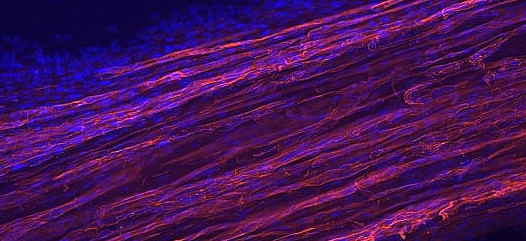A new combination of tissue engineering techniques could reduce the need for nerve grafts, according to new research by The Open University. Regeneration of nerves is challenging when the damaged area is extensive, and surgeons currently have to take a nerve graft from elsewhere in the body, leaving a second site of damage. Nerve grafts contain aligned tissue structures and Schwann cells that support and guide neuron growth through the damaged area, encouraging function to be restored. The research, published in Biomaterials, reported a way to manufacture artificial nerve tissue with the potential to be used as an alternative to nerve grafts.
Pieces of Engineered Neural Tissue (EngNT) are formed by controlling natural Schwann cell behaviour in a three-dimensional collagen gel so that the cells elongate and align, then a stabilisation process removes excess fluid to leave robust artificial tissues. These living biomaterials contain aligned Schwann cells in an aligned collagen environment, recreating key features of normal nerve tissue.
Incorrect orientation of regenerating nerve cells can lead to delays in repair, scarring and poor restoration of nerve function. Much research has taken place into how support cells (Schwann cells) can be combined with materials to guide nerve regeneration. The new technology from The Open University avoids the use of synthetic materials by building neural tissue from collagen, a protein that is abundant in normal nerve tissue. Building the artificial tissue from natural proteins and directing the cellular alignment using normal cell-material interactions means the EngNT can integrate effectively at the repair site.
Dr James Phillips, Lecturer in Health Sciences at The Open University, said: “We previously reported how self-alignment of Schwann cells could be achieved by using a tethered collagen hydrogel, which exploited cells’ natural ability to orientate in the appropriate direction by using their internal contraction forces. Our current research shows that cell-alignment in the hydrogel can be stabilised using plastic compression. The compression removes fluid from the gels, leaving a strong and stable aligned structure that has many features in common with nerve tissue.”
The team incorporated Schwann cells within the aligned material to form artificial neural tissue that could potentially be used in peripheral nerve repair. The technique could be applied to other regenerative medicine scenarios, where a stable artificial tissue containing aligned cellular architecture would be of benefit.
Story Source:
The above story is reprinted from materials The Open University.





